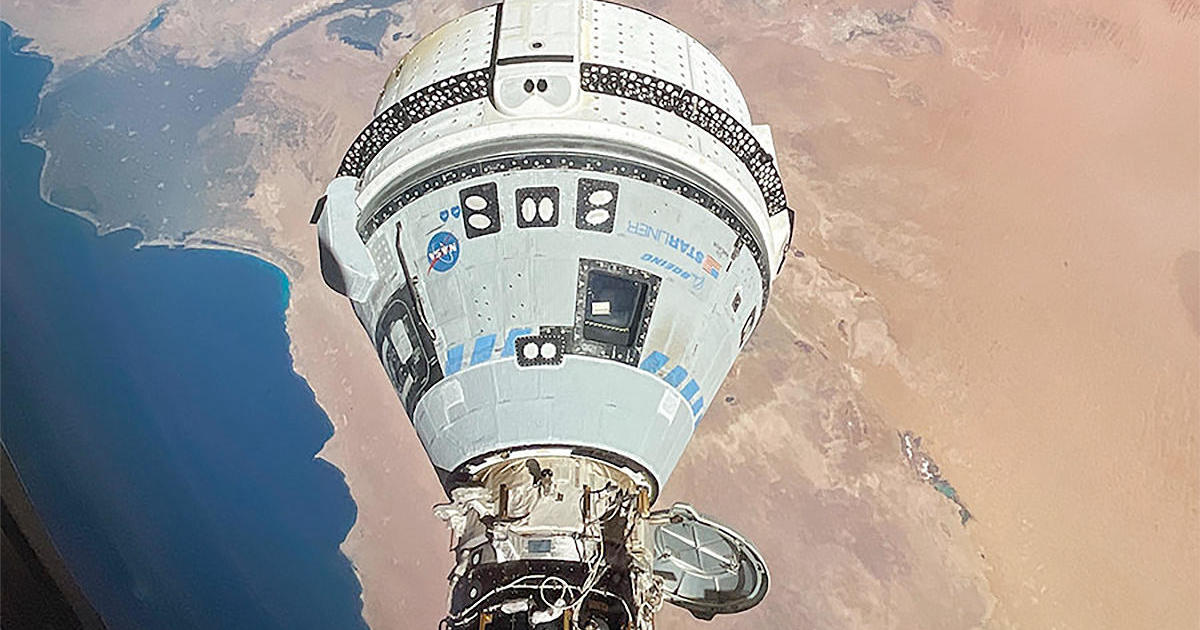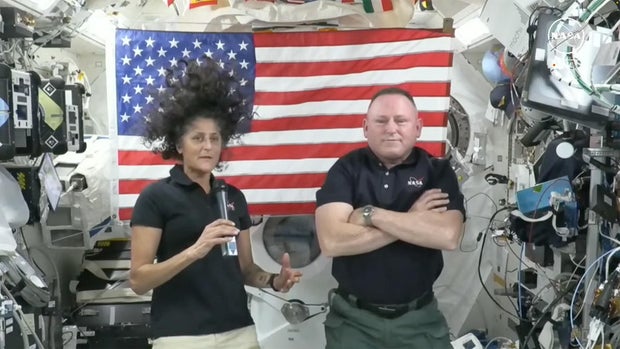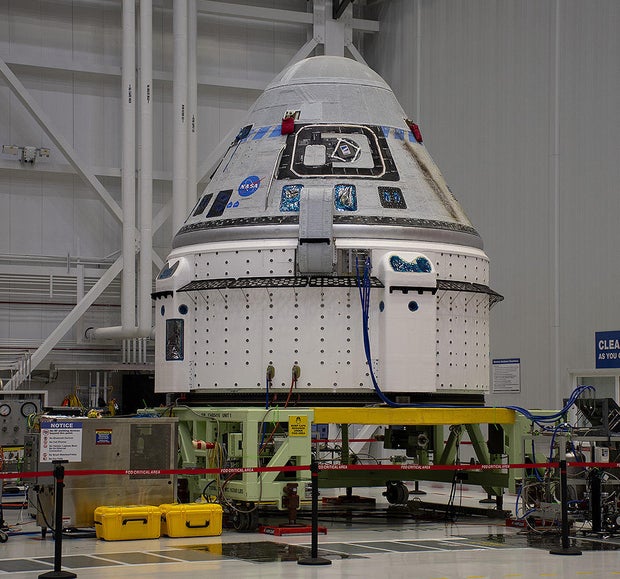As NASA debates the safety of Boeing’s Starliner spacecraft in the wake of multiple helium leaks and thruster issues, the agency is “getting more serious” about a backup plan to bring the ship’s two crew members back to Earth aboard a SpaceX Crew Dragon, officials said Wednesday.
In that case — and no final decisions have been made — Starliner commander Barry “Butch” Wilmore and co-pilot Sunita Williams would remain aboard the International Space Station for another six months and come down on a Crew Dragon that’s scheduled for launch Sept. 24 to carry long-duration crew members to the outpost.
NASA
Two of the four “Crew 9” astronauts already assigned to the Crew Dragon flight would be bumped from the mission and the ship would be launched with two empty seats. Wilmore and Williams then would return to Earth next February with the two Crew 9 astronauts.
Shortly before the Crew Dragon launch, the Starliner would undock from the station’s forward port and return to Earth under computer control, without any astronauts aboard. The Crew Dragon then would dock at the vacated forward port.
Two earlier Starliner test flights were flown without crews and both landed successfully. The current Starliner’s computer system would need to be updated with fresh data files, and flight controllers would need to brush up on the procedures, but that work can be done in time to support a mid September return.
If that scenario plays out, Wilmore and Williams would end up spending 268 days — 9.7 months — in space instead of the week or so they planned when they blasted off atop a United Launch Alliance Atlas 5 rocket on June 5.
Based on uncertainty about the precise cause of the thruster problems, “I would say that our chances of an uncrewed Starliner return have increased a little bit based on where things have gone over the last week or two,” said Ken Bowersox, NASA’s director of space operations.
“That’s why we’re looking more closely at that option to make sure that we can handle it.”
But he cautioned that no final decisions will be made on when — or how — to bring the Starliner crew home until the agency completes a top-level flight readiness review.
No date has been set, but it could happen by late next week or the week after.
“Our prime option is to return Butch and Suni on Starliner,” said Steve Stich, manager of NASA’s Commercial Crew Program. “However, we have done the requisite planning to make sure we have other options open. We have been working with SpaceX to ensure that they’re ready to (return) Butch and Suni on Crew 9 if we need that.
“Now, we haven’t approved this plan (yet). We’ve done all the work to make sure this plan is there … but we have not turned that on formally. We wanted to make sure we had all that flexibility in place.”
Before the Starliner was launched, NASA and Boeing engineers knew about a small helium leak in the spacecraft’s propulsion system. After ground tests and analysis, the team concluded the ship could be safely launched as is.
NASA
The day after launch, however, four more helium leaks developed and five aft-facing maneuvering thrusters failed to operate as expected. Ever since, NASA and Boeing have been carrying out data reviews and ground tests in an effort to understand exactly what caused both issues.
The Starliner uses pressurized helium to push propellants to the thrusters, which are critical to keeping the spacecraft properly oriented. That’s especially important during the de-orbit braking “burn” using larger rocket engines to slow the ship down for re-entry and an on-target landing.
To clear the Starliner for a piloted return to Earth, engineers must develop acceptable “flight rationale” based on test data and analyses that provides confidence the ship can make it through re-entry and landing with the required level of safety.
“The Boeing team (is) very confident that the vehicle could bring the crew home right now with the uncertainty we’ve got,” said Bowersox. “But we’ve got other folks that are probably a little more conservative. They’re worried that we don’t know for sure, so they estimate the risk higher and they would recommend that that we avoid coming home (on Starliner) because we have another option.
“So that’s a part of the discussion that we’re having right now. But again, I think both views are reasonable with the uncertainty band that we’ve got, and so our effort is trying to reduce that uncertainty.”
Boeing adamantly argues the Crew Dragon backup plan isn’t needed and that tests and analyses of helium leaks in the Starliner’s propulsion system and initial trouble with maneuvering thrusters show the spacecraft has more than enough margin to bring Wilmore and Williams safely back to Earth.
The helium leaks are understood, Boeing says, they have not gotten worse and more than enough of the pressurized gas is on board to push propellants to the thrusters needed to maneuver and stabilize the spacecraft through the critical de-orbit braking burn to drop out of orbit for re-entry and landing.
Likewise, engineers believe they now understand what caused a handful of aft-facing maneuvering jets to overheat and fire at lower-than-expected thrust during rendezvous with the space station, causing the Starliner’s flight computer to shut them down during approach.
Ground tests of a new Starliner thruster, fired hundreds of times under conditions that mimicked what those aboard the spacecraft experienced, replicated the overheating signature, which was likely caused by multiple firings during tests of the capsule’s manual control system during extended exposure to direct sunlight.
The higher-than-expected heating likely caused small seals in thruster valve “poppets” to deform and expand, the analysis indicates, which reduced the flow of propellant. The thrusters aboard the Starliner were test fired in space under more normal conditions and all operated properly, indicating the seals had returned to a less intrusive shape.
New procedures are in place to prevent the overheating that occurred during the rendezvous. Additional manual test firings have been ruled out, no extended exposure to the sun is planned and less frequent firings are required for station departure compared to rendezvous.
William Harwood/CBS News
In a statement Wednesday, Boeing said, “We still believe in Starliner’s capability and its flight rationale. If NASA decides to change the mission, we will take the actions necessary to configure Starliner for an uncrewed return.”
The helium plumbing and thrusters are housed in the Starliner’s service module, which will be jettisoned to burn up in the atmosphere before the crew capsule re-enters for landing. As such, engineers will never be able to examine the hardware first hand to prove, with certainty, what went wrong.
At this point, that uncertainty appears to support bringing Wilmore and Williams back to Earth aboard the Crew Dragon. But it’s not yet a certainty.
“If we could replicate the physics in some offline testing to understand why this poppet is heating up and extruding and then why it’s contracting, that would give us additional confidence to move forward, to return Butch and Sonny on this vehicle,” Stich said.
“That’s what the team is really striving to do, to try to look at all the data and see if we can get a good physical explanation of what’s happening.”
In the meantime, the wait for a decision, one way or the other, drags on.
“In the end, somebody – some one person – designated to be the decision maker, that person has to come to a conclusion,” Wayne Hale, a former shuttle flight director and program manager, wrote in a blog post earlier this week.
“The engineers will always always always ask for more tests, more analysis, more time to get more information to be more certain of their conclusions. The decider also has to decide when enough has been done. The rub in all of this … is that it always involves the risk to human life.”
Hale concluded his post by saying: “I do not envy today’s decision makers, the ones weighing flight rationale. My only advice is to listen thoroughly, question effectively, ask for more data when necessary. But when it is time, a decision must be made.”



